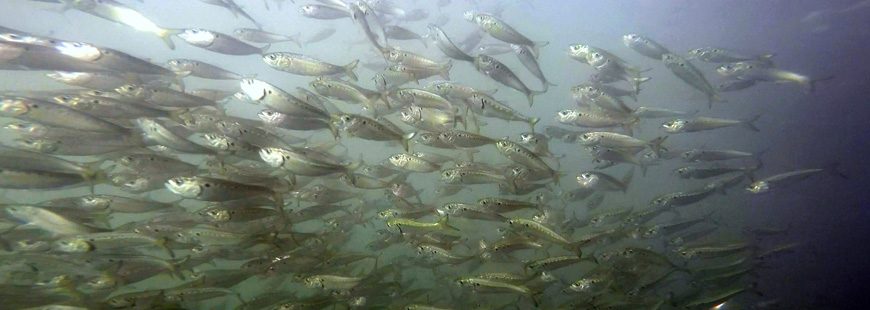Draft Amendment 3 to the Interstate Management Plan for Atlantic Menhaden Finally Offers a Way to Protect “The Most Important Fish in the Sea”
In nature, you cannot do just one thing, as Walter Youngquist puts it, because everything is connected to everything else. That’s why you can’t fish for Atlantic menhaden without impacting the ocean ecosystem and why the Atlantic States Marine Fisheries Commission is on the verge of amending its fishing rules for what many call “the most important fish in the sea”, because of its vital role as prey for so many predators – larger fish, birds and marine mammals – up and down the east coast.
The 15-state Commission is holding hearings and taking written comments through October 20th on Amendment 3 to the Interstate Fishery Management Plan for Atlantic Menhaden. The focal point of the amendment, as far as conservationists and the majority of east coast fishermen are concerned, is setting new, precautionary standards, known as “ecological reference points”, designed to leave enough menhaden in the water for dependent predators while allowing reasonable yields to the menhaden fisheries.
Why we need ERPs for menhaden…NOW
Menhaden are Key to a Healthy Coastal Ecosystem
Ecological reference points (ERPs) will protect the critical role of menhaden as forage by maintaining a larger population, which means more food in the water for dependent predators and more robust east coast fisheries, sport and commercial.
Atlantic menhaden occupy an important link in the coastal marine food chain, according to Draft Amendment 3, transferring energy from plankton into animal biomass. Menhaden support a wide variety of predator species, including important commercial and recreational fish such as striped bass and bluefish, iconic birds such as osprey and bald eagles, and charismatic marine mammals such as the humpback whale. Reduced menhaden populations impact the abundance and diversity of predator populations, particularly if other prey options are limited or unavailable. Given menhaden are found from Maine to Florida, the species serves an ecological role along much of the Atlantic coast. Thus, maintaining a healthy Atlantic menhaden population contributes to a balanced marine ecosystem. [Source: Draft Amendment 3]
Marine predators depend on menhaden
Striped bass and osprey are just two of the many predators whose numbers are directly linked to the abundance of menhaden.

Striped bass
A brand new study of ecological reference points for menhaden validates what anglers know full well – the health of the striper population is directly linked to the abundance of menhaden. Fewer menhaden in the water means fewer striped bass.
The diets of many seabirds on the Atlantic coast are predominantly menhaden, according to the Audubon Society. For the osprey, for example, menhaden make up 75-100% of their diet, depending on the time of year.

Osprey
The effects of predators not finding enough menhaden ripple throughout the food web. Forced to turn to other prey, competition for a finite food base intensifies, with a loser for every winner. Hungry striped bass in Chesapeake Bay, for instance, are consuming larger quantities of bay anchovy, a staple in the diet of weakfish, along with larger numbers of young weakfish, severely depressing a population that supported stable fisheries for 200 years. [Source: Resource Sharing]
Choose Issue 2, Option E – Interim Use of 75% Target, 40% Threshold
It’s the best available science
Wild Oceans is supporting ERP Option E – “The 75% Solution” – because it’s the best available science and it’s ready to be implemented in 2018.
We have been advocating for the “75% Solution” since June 2009, when, after reviewing the scientific literature, we submitted a white paper recommending a target population of 75% of an un-fished population and an overfished threshold of BMSY, approximately 40% of un-fished biomass. Subsequently, Smith et al and the Lenfest Ocean Program published peer reviewed papers by multiple co-authors, revealing an emerging consensus around the 75/40 ‘rule of thumb’ approach to conserving forage species. This consensus and the rationale behind it is discussed and referenced in depth in the landmark 2015 Wild Oceans report, Resource Sharing: The Berkeley Criterion.
Now, eight years later, the 75/40 option is presented as Ecological Reference Point Option E in Draft Amendment 3 to the Interstate Menhaden Plan. It has strong backing within the scientific community and is ready to be implemented now, fairly balancing the needs of the ecosystem with those of the fisheries for menhaden and other species.
Status Quo is NOT an Option!

Fishing is better when there are plenty of menhaden around
Option E allows for work to continue on the development and testing of menhaden-specific ecosystem models, but waiting years until they are usable (Option B) is unnecessary and extremely risky
If adopted, Option E reference points would stay in place while a team of ASMFC scientists works on multi-species models and evaluates their ability to suggest alternative ERPs more specific to menhaden. This work is slated to be completed by the end of 2019 – a timeline the researchers admit is “ambitious” – after which the results will be peer reviewed and then tested through what’s called a process called a Management Strategy Evaluation. If the ASMFC considers the models appropriate for meeting agreed-upon ecosystem objectives, they likely would not be implemented before the 2022 fishing season.
The Commission has been talking about implementing an ecosystems approach to conserve menhaden for at least 15 years. Further delay is unnecessary and very risky. In fact, the strongest argument against delay is the prospect of the fishery being managed another 5 years or more using the current, single-species reference points, which could allow for a more than 40% increase over current catch levels, resulting in a loss of the growth in the menhaden stock we’ve seen in recent years.
The Menhaden Constituency: These Are Your Fish – Own Them!
The menhaden industry does not own the resource, it belongs to all of us.
We enjoy the fisheries menhaden support, directly and indirectly, value the wildlife it sustains, and benefit socially and economically from a healthy and diverse ocean environment. The public pays the costs of management – from stock assessments and all the science that goes into them to fisheries regulation, monitoring and enforcement. The ASMFC has a responsibility to manage and conserve menhaden for the greatest benefit to the nation as a whole.
How and when to comment
Members of the public are encouraged to submit comments on Draft Amendment 3 during the public comment period, which is open now. Comments must be received by 5:00 PM (EST) on October 20, 2017. And check out this list of public hearing locations and dates to find one near you.
Key Points to Make
- Say you support ERP Option E because it is the best science available and will protect menhaden’s ecological role NOW, not later
- Insist that the ASMFC manage to the TARGET. Maintaining this level of abundance in the water is the goal for a forage species, not simply preventing a collapse (threshold)
- Emphasize that Option E will provide interim protection for menhaden while studies continue, but the results of those studies are uncertain and years away
- Remind the ASMFC that menhaden belong to the public and tell the commissioners why you, personally, care about the future of menhaden
Comment by Mail: Megan Ware, Atlantic States Marine Fisheries Commission, 1050 N. Highland Street, Suite 200 A-N, Arlington, VA 22201
Comment by Email: comments@asmfc.org (Subject: Draft Amd. 3)
For more information, phone (703) 842-0741
This post first appeared on WildOceans.org



Pingback: Menhaden Update from the Marine Conservation Network